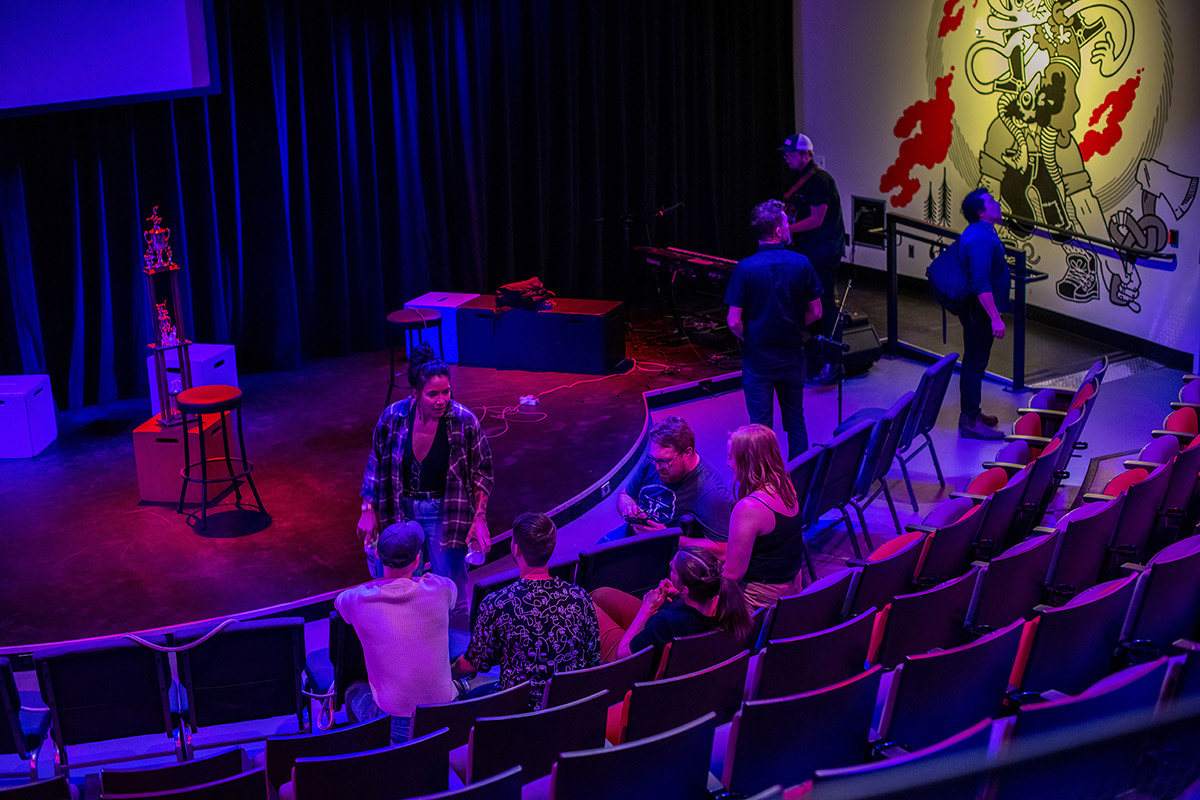
Hold the phone – we’re home at last.
A giant eye keeps watch from its perch above the bar in the lounge of the Rapid Fire Exchange. Laughter drifts from the 160-seat theatre, and it’s clear that this is a fitting home for Edmonton’s longest-running improvised theatre company, Rapid Fire Theatre.
“Welcome to our home,” says Matt Schuurman, artistic director for the company, with a laugh.
With a history dating back more than forty years, the Rapid Fire Theatre improv group is a cornerstone of Edmonton’s arts and cultural scene. It has put on countless shows over the years, including Theatresports, Improvaganza and Die-Nasty, a live improvised soap opera. But throughout its history, the group has never had a permanent home base, operating instead out of theatres across the city, from the Citadel and the Varscona to the old Roxy, just to name a few.
That all changed in the spring of 2023, when the long-anticipated Rapid Fire Exchange building opened its doors.
“Getting into this space just felt like such an important milestone for us,” says Schuurman.
Like the theatre company, the Rapid Fire Exchange building also has a long and storied history in Edmonton. It dates back to the early 1900s, when it was used as a telephone exchange – think rooms full of switchboards and wires used to connect calls – but as the technology used to connect phones grew smaller and smaller, the building was no longer needed for its intended purpose. Eventually, it came to house the Telephone Historical Information Centre, a museum dedicated to the history of telecommunications. After the museum relocated in 2004, the space sat largely unused, save for a few weeks every year when it acted as a venue during the Edmonton International Fringe Theatre Festival.
Although the building’s interior was dated and in need of renovation, its potential as a venue piqued the interest of the theatre company.
“We’ve been searching for a home to call our own for quite some time. And the proximity here to the Fringe grounds as well as to our old home of the old Varscona Theatre just a block away, was perfect for us,” says Schuurman.
But as perfect as the location was, financing renovations to modernize the space proved to be difficult.
“Being a not-for-profit with no equity, banks just run us through a calculator and the answer is always ‘No,’” says Schuurman.
“So for an organization like SEF that understands the cultural capital we have to offer and understand the success of our 40 years of business, they did see the merit in that and worked with us to do that loan. And that has provided absolutely vital bridge financing to make this happen.”
After signing a long-term lease with Telus — the building’s owner — in 2021, work began to turn the gutted-out museum into a theatre.
But the exchange is still a work in progress. Phase one of the project involved rejuvenating most of the public-facing areas: the lounge and lobby, the theatre space and the gender-neutral washrooms on the main floor. Phase two, which has not yet begun, involves renovating the basement to create workshop, rehearsal and classroom spaces.
There’s a lot to be done, but much like the giant eye, Schuurman has a vision for what could be.
“Everything you see here today – we designed and built new. There’s some big unknowns still in terms of what the next steps are and whether or not we go full steam ahead,” he says. “But so far, it’s been going great.”
SVI Alberta is a conference held in Alberta where entrepreneurs, impact venture leaders, and changemakers gather to build their network and learn from each other through sharing experiences in a safe and supportive space.
Edmonton 3 October 2024 The Edmonton Community Foundation today announced the appointment of Ryan Young as the Director of the Social Enterprise Fund.
After thirteen years in the Executive Director chair at SEF, it is time for me to move on.